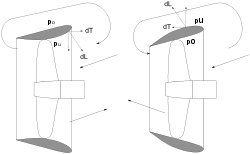- Ducted propeller
-
A ducted propeller is a propeller fitted with a non-rotating nozzle. It is used to improve the efficiency of the propeller and are especially used on heavily loaded propellers or propellers with limited diameter. It was developed by Luigi Stipa (1931) and Ludwig Kort (1934).
Advantages are increased efficiency, better course stability and less vulnerability to debris. Downsides are reduced efficiency and course stability when sailing astern and increase of cavitation. Ducted propellers are also used to replace rudders.
Types
There are two types of ducts; accelerating and decelerating. With accelerating ducts, the inflow velocity and efficiency of the propeller is increased. This is the type that is used on heavily loaded propellers or propellers with limited diameter. As Ludwig Kort performed extensive research on this type, it is often called Kort nozzle.
With the second type, the inflow velocity is reduced, whereby pressure is increased, reducing cavitation. This is called a pump-jet, especially in combination with fixed blades or stators.
MARIN has done extensive research on ducted propellers. Many of the used profiles are based on the NACA airfoils of which the NACA 4415 has very good characteristics. Most commonly used are nozzle 19A and 37 of the MARIN series. Thes have a rounded trailing edge to ease fabrication and increase efficiency sailing astern. Initially, the propellers of the Wageningen B-series were used, later the Kaplan-type with a wider blade tip.
Physics
Circulation around accelerating and decelerating nozzle 
dT = Thrust
dL = Liftpu: Negative pressure
po: Positive pressureIn a Kort nozzle, the inflow velocity is increased, reducing pressure. This lowers thrust and torque of the propeller. At the same time, a circulation occurs, resulting in an inward aimed force, that has a forward component. The duct therefore has a positive thrust. This is normally larger than the thrust reduction of the propeller. The small clearance between the propeller and duct reduces tip vortex, increasing efficiency.
As drag increases with increasing speed, eventually this will become larger than the added thrust. Vessels that normally operate above this speed are therefore normally not fitted with ducts. When towing, tugboats sail with low speed and heavily loaded propellers, and are often fitted with ducts. Bollard pull can increase up to 30% with ducts.
With decelerating ducts, the circulation opposite of the Kort nozzle, resulting in a negative thrust of the duct. This type is used for high speed vessels with increased exposure to cavitation and vessels that want to reduce noise levels, such as warships.
Bibliography
- Carlton, J. (2007): Marine Propellers and Propulsion, Butterworth-Heinemann
- Ghose, J.P., Gokarn R.P. (2004): Basic Ship Propulsion, Allied Publishers
- Oosterveld, M.W.C. (1970): Wake Adapted Ducted Propellers, Nederlands Schip Model Basin, Wageningen
Categories:- Propellers
- Fluid dynamics
- Marine propulsion
Wikimedia Foundation. 2010.


